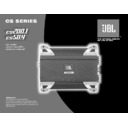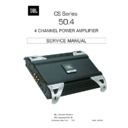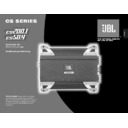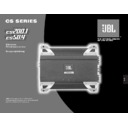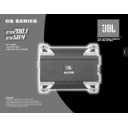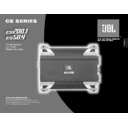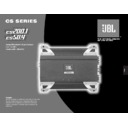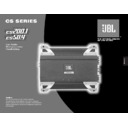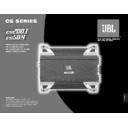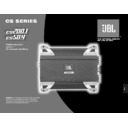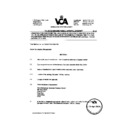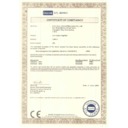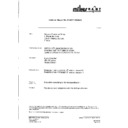JBL CS 50.4 (serv.man13) User Manual / Operation Manual ▷ View online
car audio
power amplifier
owner’s manual
power amplifier
owner’s manual
THANK YOU
for purchasing a JBL CS Series amplifier.
In order that we may better serve you should you require
warranty service for your new amplifier, please retain your
original purchase receipt and return the enclosed warranty
registration card.
In order that we may better serve you should you require
warranty service for your new amplifier, please retain your
original purchase receipt and return the enclosed warranty
registration card.
INSTALLATION
WARNING: Playing loud music in an
automobile can hinder your ability to hear
traffic and permanently damage your
hearing. We recommend listening at low or
moderate levels while driving your car. JBL
accepts no liability for hearing loss, bodily
injury or property damage resulting from the
use or misuse of this product.
automobile can hinder your ability to hear
traffic and permanently damage your
hearing. We recommend listening at low or
moderate levels while driving your car. JBL
accepts no liability for hearing loss, bodily
injury or property damage resulting from the
use or misuse of this product.
IMPORTANT: To get the best perform-
ance from your JBL CS Series amplifiers, we
strongly recommend that installation be
entrusted to a qualified professional.
Although these instructions explain how to
install CS amplifiers in a general sense, they
do not show specific installation methods
that may be required for your particular
vehicle. If you do not have the necessary
tools or experience, do not attempt the
installation yourself. Instead, please ask
your authorized JBL car audio dealer about
professional installation.
ance from your JBL CS Series amplifiers, we
strongly recommend that installation be
entrusted to a qualified professional.
Although these instructions explain how to
install CS amplifiers in a general sense, they
do not show specific installation methods
that may be required for your particular
vehicle. If you do not have the necessary
tools or experience, do not attempt the
installation yourself. Instead, please ask
your authorized JBL car audio dealer about
professional installation.
INSTALLATION
WARNINGS AND TIPS
WARNINGS AND TIPS
• Always wear protective eyewear when
using tools.
• Turn off the audio system and other
electrical devices before you start. Discon-
nect the (–) negative lead from your vehi-
cle’s battery.
nect the (–) negative lead from your vehi-
cle’s battery.
• Check clearances on both sides of a
planned mounting surface before drilling
any holes or installing any screws.
Remember that the screws can extend
behind the surface.
any holes or installing any screws.
Remember that the screws can extend
behind the surface.
• At the installation sites, locate and make a
note of all fuel lines, hydraulic brake lines,
vacuum lines and electrical wiring. Use
extreme caution when cutting or drilling in
and around these areas.
vacuum lines and electrical wiring. Use
extreme caution when cutting or drilling in
and around these areas.
• Before drilling or cutting holes, use a utility
knife to remove unwanted fabric or vinyl to
keep material from snagging in a drill bit.
keep material from snagging in a drill bit.
• When routing cables, keep input-signal
cables away from power cables and
speaker wires.
speaker wires.
• When making connections, make certain
they are secure and properly insulated.
• If the amplifier’s fuse must be replaced,
use only the same type and rating as that
of the original. Do not substitute another
kind.
of the original. Do not substitute another
kind.
CHOOSING A LOCATION
AND MOUNTING THE
AMPLIFIER
AND MOUNTING THE
AMPLIFIER
Choose a mounting location in the trunk
or cargo area where the amplifier will not be
damaged by shifting cargo. Amplifier
cooling is essential for proper amplifier
operation. If the amplifier is to be installed in
an enclosed space, make sure there is
sufficient air circulation for the amplifier
to cool itself.
or cargo area where the amplifier will not be
damaged by shifting cargo. Amplifier
cooling is essential for proper amplifier
operation. If the amplifier is to be installed in
an enclosed space, make sure there is
sufficient air circulation for the amplifier
to cool itself.
When mounting the amplifier under a seat,
ensure that it is clear of all moving seat
parts and does not affect the seat adjust-
ments. Mount the amplifier so it is not dam-
aged by the feet of backseat passengers.
Make sure that the amplifier is mounted
securely using nuts and bolts or the
supplied mounting screws.
ensure that it is clear of all moving seat
parts and does not affect the seat adjust-
ments. Mount the amplifier so it is not dam-
aged by the feet of backseat passengers.
Make sure that the amplifier is mounted
securely using nuts and bolts or the
supplied mounting screws.
Mount the amplifier so that it remains dry –
never mount an amplifier outside the vehicle
or in the engine compartment.
never mount an amplifier outside the vehicle
or in the engine compartment.
POWER CONNECTIONS
The CS amplifiers are capable of delivering
extremely high power levels, and require a
heavy-duty and reliable connection to the
vehicle’s electrical system in order to per-
form optimally. See Figure 1 for connection
location. Please adhere to the following
instructions carefully:
extremely high power levels, and require a
heavy-duty and reliable connection to the
vehicle’s electrical system in order to per-
form optimally. See Figure 1 for connection
location. Please adhere to the following
instructions carefully:
Ground Connection
Connect the amplifier’s Ground (GND) termi-
nal to a solid point on the vehicle’s metal
chassis, as close to the amplifier as possi-
ble. Refer to the chart below to determine
minimum wire-gauge size. Scrape away any
paint from this location; use a star- type lock
washer to secure the connection.
Connect the amplifier’s Ground (GND) termi-
nal to a solid point on the vehicle’s metal
chassis, as close to the amplifier as possi-
ble. Refer to the chart below to determine
minimum wire-gauge size. Scrape away any
paint from this location; use a star- type lock
washer to secure the connection.
Power Connection
Connect a wire (see chart at right for appro-
priate gauge) directly to the vehicle’s posi-
tive battery terminal, and install an appropri-
ate fuse holder within 50cm of the battery
terminal. Do not install the fuse at this time.
Route the wire to the amplifier’s location,
and connect it to the amplifier’s Positive
(+12V) terminal. Be sure to use appropriate
grommets whenever routing wires through
the firewall or other sheet metal. Failure to
adequately protect the positive wire from
potential damage may result in a vehicle
fire. When you are done routing and con-
necting this wire, you may install a 40A fuse
at the battery.
Connect a wire (see chart at right for appro-
priate gauge) directly to the vehicle’s posi-
tive battery terminal, and install an appropri-
ate fuse holder within 50cm of the battery
terminal. Do not install the fuse at this time.
Route the wire to the amplifier’s location,
and connect it to the amplifier’s Positive
(+12V) terminal. Be sure to use appropriate
grommets whenever routing wires through
the firewall or other sheet metal. Failure to
adequately protect the positive wire from
potential damage may result in a vehicle
fire. When you are done routing and con-
necting this wire, you may install a 40A fuse
at the battery.
Remote Connection
Connect the amplifier’s Remote (REM)
terminal to the source unit’s Remote Turn-On
lead using a minimum of 1mm
Connect the amplifier’s Remote (REM)
terminal to the source unit’s Remote Turn-On
lead using a minimum of 1mm
2
wire.
NOTE: If your source unit does not have a
remote turn-on connection, connect the
amplifier’s (REM) terminal to the vehicle’s
accessory circuit.
remote turn-on connection, connect the
amplifier’s (REM) terminal to the vehicle’s
accessory circuit.
Speaker Connections
Refer to the application guides on the pages
that follow. Speaker connections should be
made using a minimum of 1.5mm
Refer to the application guides on the pages
that follow. Speaker connections should be
made using a minimum of 1.5mm
2
wire.
Wire Gauge Chart
Amplifier
Amplifier
Maximum
Minimum
Model
Current Draw
Wire Gauge
CS50.4
40A
#10mm
2
CS200.1
42A
#10mm
2
These recommendations assume 1,5m à
2,5m wire runs. If your installation differs
markedly, you will need to adjust the wire
gauge accordingly.
2,5m wire runs. If your installation differs
markedly, you will need to adjust the wire
gauge accordingly.
Figure 1. Terminal connection end plate.
4
APPLICATIONS – CS200.1
The CS subwoofer amplifiers are
single-channel amplifiers. There are
two sets of terminals to make it easy
to connect multiple woofers. Either
set of (+/–) terminals may be used when
connecting woofers.
To the right are two application
diagrams to help plan your subwoofer
system installation. Figures 2 and 3
show how to configure the CS200.1
subwoofer amplifiers.
single-channel amplifiers. There are
two sets of terminals to make it easy
to connect multiple woofers. Either
set of (+/–) terminals may be used when
connecting woofers.
To the right are two application
diagrams to help plan your subwoofer
system installation. Figures 2 and 3
show how to configure the CS200.1
subwoofer amplifiers.
NOTE: For simplicity, Figures 2 and 3
do not show power, remote and input
connections.
do not show power, remote and input
connections.
NOTE: Minimum speaker load is
2 ohms.
2 ohms.
3
Figure 2. CS subwoofer amplifier with two
woofer connections.
woofer connections.
Figure 3. CS subwoofer amplifier with one woofer
connection.
connection.
Figure 4. CS50.4 amplifier in 4-channel (stereo)
operation to drive front and rear full-range speakers.
operation to drive front and rear full-range speakers.
APPLICATIONS – CS50.4
The CS50.4 can be set up for stereo
4-channel, 3-channel or bridged
2-channel operation, as shown in
Figures 4 through 6.
4-channel, 3-channel or bridged
2-channel operation, as shown in
Figures 4 through 6.
NOTE: For simplicity, Figures 4 through 6 do
not show power, remote and input
connections.
not show power, remote and input
connections.
NOTE: Minimum speaker impedance for
stereo operation is 2 ohms.
Minimum speaker impedance for bridged
operation is 4 ohms.
stereo operation is 2 ohms.
Minimum speaker impedance for bridged
operation is 4 ohms.
Figure 5. CS50.4 is set up for 3-channel operation to
drive a set of full-range speakers and a subwoofer.
drive a set of full-range speakers and a subwoofer.
Figure 6. CS50.4 used in bridged 2-channel mode
to drive a set of components or subwoofers.
Set crossovers according to application.
to drive a set of components or subwoofers.
Set crossovers according to application.
TROUBLESHOOTING
SYMPTOM
LIKELY CAUSE
SOLUTION
No audio
No voltage at BATT+
Check voltages at
(POWER LED
or REM terminals,
amplifier terminals
are off)
or bad or no ground
with VOM
connection
No audio
Amplifier is
Make sure amplifier
(POWER
overheated
cooling is not blocked
LEDs are on)
at mounting location;
verify speaker system
impedance is within
specified limits
verify speaker system
impedance is within
specified limits
Voltage more than 16V
Check vehicle
or less than 8.5V on
charging system
BATT+ connection
SYMPTOM
LIKELY CAUSE
SOLUTION
No audio
Voltage less than 9V on
Check vehicle
(POWER
BATT+ connection
charging system
LEDs flash)
DC voltage on
Amplifier may need
amplifier output
service; see enclosed
warranty card for
service information
warranty card for
service information
Distorted audio
Input sensitivity is
Check INPUT
not set properly, or
LEVEL setting; or
amplifier or source
check speaker wires
unit is defective
for shorts or grounds
Distorted audio
Short circuit in
Remove speaker leads
and POWER
speaker or wire
one at a time to locate
LED flash
shorted speaker or
wire, then repair
wire, then repair
Music lacks
Speakers are not
Check speaker
“punch”
connected properly
connections for proper polarity
CONTROLS AND SETUP
SETTING THE
CROSSOVER(S)
CROSSOVER(S)
Determine your system plans and set the
crossover mode switch accordingly. If
you plan to use the CS50.4 to drive full-
range speakers, set the crossover mode
to FLAT and skip to “Setting Input Sensi-
tivity.”
crossover mode switch accordingly. If
you plan to use the CS50.4 to drive full-
range speakers, set the crossover mode
to FLAT and skip to “Setting Input Sensi-
tivity.”
Initially set the crossover frequency
control midway. While listening to music,
adjust the crossover for the least per-
ceived distortion from the speakers,
allowing them to reproduce as much bass
as possible.
control midway. While listening to music,
adjust the crossover for the least per-
ceived distortion from the speakers,
allowing them to reproduce as much bass
as possible.
Systems using a separate subwoofer set
the crossover mode to HP (high pass) for
your full-range speakers. Adjust the
crossover frequency to limit bass and
provide increased system volume with
less distortion.
the crossover mode to HP (high pass) for
your full-range speakers. Adjust the
crossover frequency to limit bass and
provide increased system volume with
less distortion.
For subwoofers, choose the highest
frequency that removes vocal information
from the sound of the subwoofer.
frequency that removes vocal information
from the sound of the subwoofer.
If using the CS50.4 to drive a
subwoofer(s), set the crossover mode to
LP (low pass).
subwoofer(s), set the crossover mode to
LP (low pass).
SETTING INPUT
SENSITIVITY
SENSITIVITY
1. Initially turn the INPUT LEVEL control(s)
to minimum (counter clockwise).
2. Reconnect the (–) negative lead to the
vehicle’s battery. Apply power to the
audio system and play a dynamic music
track.
audio system and play a dynamic music
track.
3. On the source unit, increase the vol-
ume control to 3/4 volume. Slowly
increase the INPUT LEVEL control(s)
toward three o’clock until you hear
slight distortion
in the music. Then reduce the INPUT
LEVEL slightly until distortion is no
longer heard.
increase the INPUT LEVEL control(s)
toward three o’clock until you hear
slight distortion
in the music. Then reduce the INPUT
LEVEL slightly until distortion is no
longer heard.
NOTE: After the source unit is on, blue
LEDs (on the top panel) will light, indicat-
ing the amplifier is on. If not, check the
wiring, especially the remote connection
from the source unit. Also refer to
“Troubleshooting” guide below.
LEDs (on the top panel) will light, indicat-
ing the amplifier is on. If not, check the
wiring, especially the remote connection
from the source unit. Also refer to
“Troubleshooting” guide below.
www.jbl.com
JBL Consumer Products
250 Crossways Park Drive,
Woodbury, NY 11797 USA
250 Crossways Park Drive,
Woodbury, NY 11797 USA
© 2004 Harman International Indus-
tries, Incorporated
tries, Incorporated
JBL and Grand Touring are registered
trademarks of Harman International
Industries, Incorporated.
trademarks of Harman International
Industries, Incorporated.
Part No. CSAMPOM3/04
Declaration of Conformity
We, Harman Consumer International
2, route de Tours
72500 Chateau-du-Loir
France
72500 Chateau-du-Loir
France
declare in own responsibility that the product
described in this owner’s manual is in compliance
with technical standards:
described in this owner’s manual is in compliance
with technical standards:
EN 55013:2001
EN 55020:2002
EN 55020:2002
Emmanuel Millot
Harman Consumer International
Chateau-du-Loir, France 1/04
SPECIFICATIONS
CS200.1
• 1 x 236W RMS channel at 4 ohms and
• 1 x 236W RMS channel at 4 ohms and
≤1% THD + N
• Signal-to-noise ratio: 100dBA (reference 1W into 4 ohms)
• 1 x 338W RMS channel at 2 ohms, 14.4V supply and
• 1 x 338W RMS channel at 2 ohms, 14.4V supply and
≤1% THD + N
• Dynamic power: 464W at 2 ohms
• Effective damping factor: 6.395 at 4 ohms
• Frequency response: 10Hz – 302Hz (–3dB)
• Maximum input signal: 7.5V
• Maximum sensitivity: 260mV
• Output regulation: .073dB at 4 ohms
• Dimensions (L x W x H): 295x313x60mm
• Effective damping factor: 6.395 at 4 ohms
• Frequency response: 10Hz – 302Hz (–3dB)
• Maximum input signal: 7.5V
• Maximum sensitivity: 260mV
• Output regulation: .073dB at 4 ohms
• Dimensions (L x W x H): 295x313x60mm
(11-5/8" x 12-5/16" x 2-3/8")
• Fuses: 20A x 2
CS50.4
• 4 x 67W RMS channels at 4 ohms and
• 4 x 67W RMS channels at 4 ohms and
≤1% THD + N
• Signal-to-noise ratio: 86dBA (reference 1W into 4 ohms)
• 4 x 82W RMS channels at 2 ohms, 14.4V supply and
• 4 x 82W RMS channels at 2 ohms, 14.4V supply and
≤1% THD + N
• 2 x 162W RMS channels at 4 ohms, 14.4V supply and
≤1% THD + N
• Dynamic power: 145W at 2 ohms
• Effective damping factor: 6.395 at 4 ohms
• Frequency response: 10Hz – 27kHz (–3dB)
• Maximum input signal: 6V
• Maximum sensitivity: 240mV
• Output regulation: .032dB at 4 ohms
• Dimensions (L x W x H): 384x313x60mm
• Effective damping factor: 6.395 at 4 ohms
• Frequency response: 10Hz – 27kHz (–3dB)
• Maximum input signal: 6V
• Maximum sensitivity: 240mV
• Output regulation: .032dB at 4 ohms
• Dimensions (L x W x H): 384x313x60mm
(15-1/8" x 12-5/16" x 2-3/8")
• Fuses: 25A x 2
Features, specifications and appearance
are subject to change without notice.
are subject to change without notice.
Display

